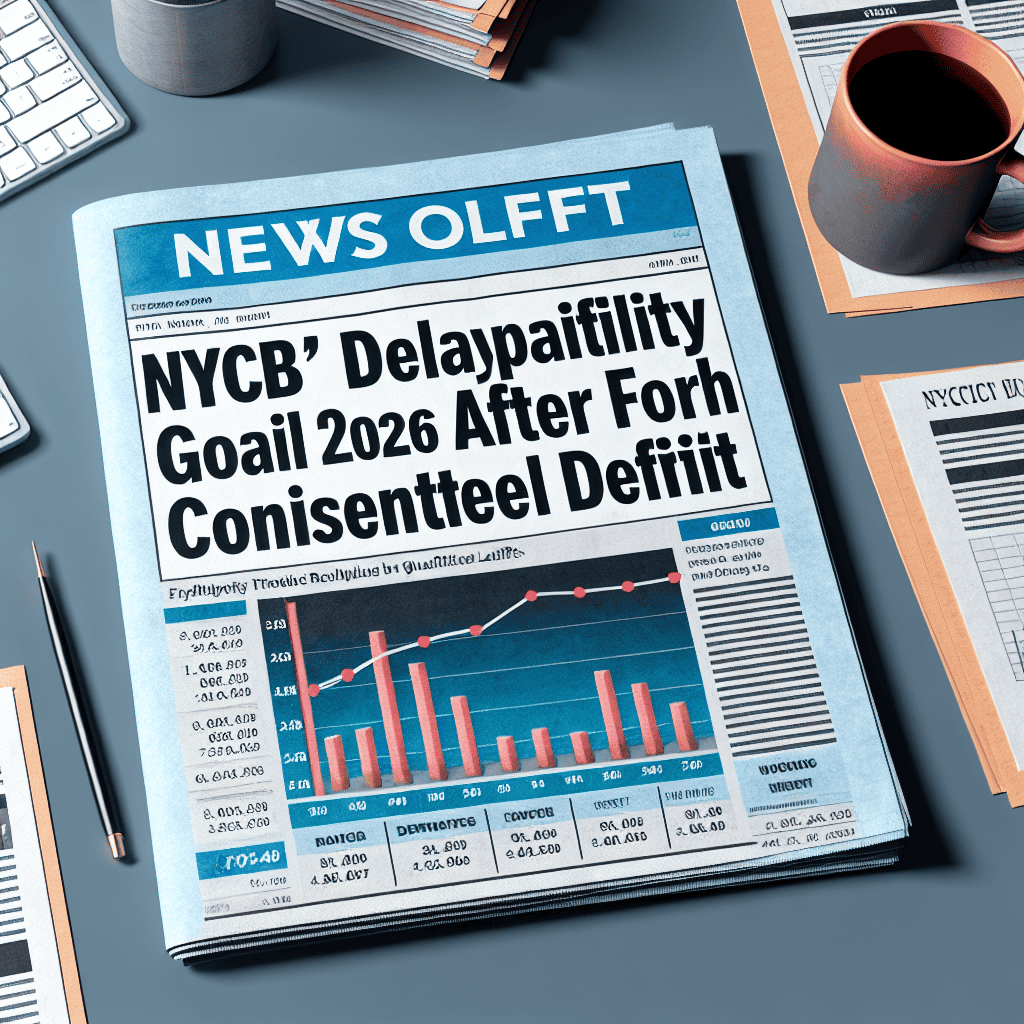“NYCB: Navigating Challenges, Aiming for Profitability by 2026”
Introduction
New York Community Bancorp (NYCB) has announced a delay in its profitability target, now aiming for 2026, following its fourth consecutive quarterly loss. This decision reflects ongoing financial challenges and market conditions impacting the bank’s performance. The postponement underscores the company’s strategic reassessment as it navigates a complex economic landscape, striving to stabilize its financial footing and achieve sustainable growth. NYCB’s leadership remains focused on implementing measures to enhance operational efficiency and improve its financial outlook in the coming years.
Impact Of NYCB’s Profitability Delay On Investors
The recent announcement by New York Community Bancorp (NYCB) to postpone its profitability target to 2026 has sent ripples through the investment community, particularly as it follows the bank’s fourth consecutive quarterly loss. This decision has significant implications for investors, who are now faced with reassessing their strategies and expectations regarding the bank’s financial performance. As NYCB navigates this challenging period, understanding the broader impact on investors becomes crucial.
To begin with, the delay in achieving profitability underscores the persistent challenges NYCB faces in its operational environment. The bank has been grappling with a series of financial setbacks, which have been exacerbated by broader economic conditions, including fluctuating interest rates and regulatory pressures. These factors have collectively contributed to the bank’s inability to meet its profitability targets, thereby necessitating a revision of its financial timeline. For investors, this delay signals a need for caution and a reevaluation of the bank’s long-term viability.
Moreover, the postponement of profitability targets can lead to a shift in investor sentiment. Confidence in a company’s ability to generate profits is a critical factor that influences investment decisions. With NYCB pushing its profitability target further into the future, some investors may perceive this as a sign of underlying weaknesses within the bank’s operational framework. Consequently, this could result in a decline in stock prices as investors adjust their portfolios to mitigate potential risks. The market’s reaction to such announcements often reflects broader concerns about a company’s strategic direction and its capacity to overcome financial hurdles.
In addition to affecting investor sentiment, the delay in profitability targets may also impact NYCB’s ability to attract new investors. Potential investors typically seek opportunities that promise growth and financial stability. With the bank’s profitability now projected further down the line, it may become less attractive to those looking for immediate returns. This could lead to a reduced influx of capital, which is essential for NYCB to invest in growth initiatives and improve its financial standing. As a result, the bank may need to explore alternative strategies to bolster investor confidence and secure the necessary funding for its operations.
Furthermore, the postponement of profitability targets raises questions about NYCB’s strategic priorities and its approach to addressing current challenges. Investors will likely scrutinize the bank’s future plans, seeking assurances that it has a robust strategy in place to achieve its revised targets. This may involve a closer examination of the bank’s cost management practices, revenue generation strategies, and efforts to enhance operational efficiency. Transparency and clear communication from NYCB’s management will be crucial in maintaining investor trust and demonstrating a commitment to overcoming the obstacles that have hindered profitability.
In conclusion, NYCB’s decision to delay its profitability target to 2026 has significant implications for investors, affecting both sentiment and investment strategies. As the bank navigates this challenging period, it must address investor concerns by demonstrating a clear and effective plan for achieving its financial goals. For investors, this development necessitates a careful reassessment of their positions and a consideration of the potential risks and rewards associated with continued investment in NYCB. Ultimately, the bank’s ability to regain investor confidence will hinge on its capacity to adapt to changing market conditions and deliver on its revised profitability timeline.
Analyzing NYCB’s Financial Strategies Amid Losses
New York Community Bancorp (NYCB) has recently announced a postponement of its profitability target to 2026, following its fourth consecutive quarterly loss. This decision marks a significant shift in the bank’s financial strategy, as it grapples with ongoing challenges in the current economic climate. The delay in achieving profitability underscores the complexities faced by financial institutions in navigating a landscape marked by fluctuating interest rates, regulatory pressures, and evolving consumer expectations.
The bank’s recent financial performance has been impacted by a confluence of factors, including rising interest rates and increased competition in the banking sector. These elements have exerted pressure on NYCB’s net interest margin, a critical measure of profitability for banks. As interest rates rise, the cost of borrowing increases, which can lead to a decrease in loan demand. Simultaneously, banks must offer higher interest rates on deposits to attract and retain customers, further squeezing profit margins. In this context, NYCB’s decision to extend its profitability target reflects a strategic recalibration aimed at ensuring long-term sustainability.
Moreover, regulatory changes have also played a role in shaping NYCB’s financial strategies. The implementation of stricter capital requirements and enhanced scrutiny of lending practices have necessitated a more cautious approach to growth. These regulations, while designed to ensure the stability of the financial system, have inadvertently added layers of complexity to the bank’s operations. Consequently, NYCB has had to balance compliance with these regulations while striving to maintain competitive advantage and shareholder value.
In response to these challenges, NYCB has embarked on a series of strategic initiatives aimed at bolstering its financial position. One such initiative involves a renewed focus on cost management. By streamlining operations and optimizing resource allocation, the bank aims to improve efficiency and reduce expenses. This approach not only addresses immediate financial pressures but also positions NYCB to capitalize on future growth opportunities as market conditions stabilize.
Additionally, NYCB is exploring avenues for diversification to mitigate the impact of interest rate fluctuations on its core business. By expanding its product offerings and entering new markets, the bank seeks to create alternative revenue streams that can offset potential declines in traditional banking income. This diversification strategy is complemented by investments in technology and digital transformation, which are essential for meeting the evolving needs of customers in an increasingly digital world.
Furthermore, NYCB’s leadership has emphasized the importance of maintaining strong relationships with its customer base. By prioritizing customer service and engagement, the bank aims to foster loyalty and trust, which are crucial for sustaining business in challenging times. This customer-centric approach is expected to enhance the bank’s reputation and support its efforts to attract new clients and retain existing ones.
In conclusion, NYCB’s decision to postpone its profitability target to 2026 reflects a pragmatic response to the multifaceted challenges it faces. By focusing on cost management, diversification, and customer engagement, the bank is laying the groundwork for a more resilient and adaptable business model. While the path to profitability may be longer than initially anticipated, these strategic initiatives are designed to ensure that NYCB emerges stronger and more competitive in the years to come. As the financial landscape continues to evolve, the bank’s ability to navigate these changes will be critical to its success and sustainability.
NYCB’s Path To Profitability: Challenges And Opportunities
New York Community Bancorp (NYCB) has recently announced a postponement of its profitability target to 2026, following its fourth consecutive quarterly loss. This decision underscores the challenges the bank faces in navigating a complex financial landscape. As NYCB grapples with these difficulties, it is essential to examine both the obstacles it encounters and the opportunities that may arise on its path to profitability.
The bank’s recent financial performance has been impacted by a confluence of factors, including rising interest rates, increased competition, and regulatory pressures. These elements have collectively contributed to a challenging operating environment, making it difficult for NYCB to achieve its profitability goals. Rising interest rates, in particular, have exerted pressure on the bank’s net interest margin, a critical measure of profitability for financial institutions. As borrowing costs increase, the spread between the interest NYCB earns on loans and the interest it pays on deposits narrows, thereby squeezing profits.
Moreover, the competitive landscape in the banking sector has intensified, with both traditional banks and fintech companies vying for market share. This heightened competition has compelled NYCB to innovate and adapt its offerings to meet evolving customer expectations. However, such adaptations often require significant investments in technology and infrastructure, which can further strain financial resources in the short term. Additionally, regulatory requirements continue to evolve, necessitating compliance measures that can be costly and time-consuming.
Despite these challenges, NYCB is not without opportunities. The bank’s strategic initiatives aimed at enhancing operational efficiency and expanding its customer base could pave the way for future growth. By leveraging technology to streamline operations and improve customer experiences, NYCB can position itself more competitively in the market. Furthermore, the bank’s focus on niche markets, such as multifamily lending, provides a unique opportunity to capitalize on its expertise and build a loyal customer base.
In addition to these strategic initiatives, NYCB’s commitment to maintaining a strong capital position is a crucial factor in its long-term success. A robust capital base not only provides a buffer against potential losses but also enables the bank to invest in growth opportunities as they arise. By prudently managing its capital and risk exposure, NYCB can navigate the current economic uncertainties while laying the groundwork for future profitability.
As NYCB charts its course toward profitability, effective leadership and strategic decision-making will be paramount. The bank’s management team must remain agile and responsive to changing market conditions, while also maintaining a clear focus on long-term objectives. By fostering a culture of innovation and adaptability, NYCB can better position itself to overcome the challenges it faces and seize the opportunities that lie ahead.
In conclusion, while NYCB’s postponement of its profitability target to 2026 reflects the difficulties it currently faces, it also highlights the bank’s commitment to addressing these challenges head-on. By strategically navigating the complex financial landscape and capitalizing on its strengths, NYCB has the potential to achieve sustainable profitability in the years to come. As the bank continues to adapt and evolve, its journey toward profitability will undoubtedly be shaped by both the challenges it encounters and the opportunities it embraces.
Market Reactions To NYCB’s Revised Profitability Timeline

New York Community Bancorp (NYCB) recently announced a significant shift in its financial strategy, postponing its profitability target to 2026 after experiencing its fourth consecutive quarterly loss. This decision has sparked varied reactions in the market, with investors and analysts closely scrutinizing the implications of this revised timeline. The delay in achieving profitability underscores the challenges NYCB faces in navigating a complex financial landscape, marked by fluctuating interest rates and evolving regulatory requirements. As the bank grapples with these hurdles, stakeholders are keenly observing how this strategic pivot will impact its long-term growth prospects and market position.
In the wake of NYCB’s announcement, market reactions have been mixed. On one hand, some investors express concern over the bank’s ability to return to profitability, questioning the effectiveness of its current strategies. The consecutive quarterly losses have raised red flags, prompting a reevaluation of NYCB’s operational efficiencies and cost management practices. These investors worry that the extended timeline may indicate deeper underlying issues that could hinder the bank’s recovery efforts. Consequently, there has been a noticeable dip in NYCB’s stock price, reflecting the market’s apprehension about the bank’s future performance.
Conversely, other market participants view the revised profitability target as a prudent move, allowing NYCB to recalibrate its strategies and focus on sustainable growth. By extending the timeline, the bank gains the flexibility to implement necessary changes without the pressure of immediate financial targets. This perspective is bolstered by NYCB’s commitment to enhancing its digital capabilities and expanding its product offerings, which are seen as crucial steps in adapting to the evolving banking landscape. Proponents of this view argue that the bank’s long-term vision, coupled with strategic investments, could ultimately yield positive results, positioning NYCB for a stronger comeback.
Moreover, analysts emphasize the importance of external factors in shaping NYCB’s profitability trajectory. The current economic environment, characterized by interest rate volatility and regulatory shifts, presents both challenges and opportunities for the bank. As interest rates fluctuate, NYCB must navigate the impact on its net interest margin, a critical determinant of profitability. Additionally, regulatory changes necessitate ongoing adjustments to compliance frameworks, further influencing the bank’s operational dynamics. In this context, the revised timeline is seen as a strategic response to external pressures, allowing NYCB to align its operations with the broader economic landscape.
Furthermore, the market’s reaction to NYCB’s announcement highlights the broader sentiment towards the banking sector’s resilience in the face of economic uncertainties. Investors are increasingly focused on banks’ ability to adapt to changing conditions, with an emphasis on digital transformation and customer-centric approaches. NYCB’s efforts to enhance its technological infrastructure and improve customer experiences are viewed as essential components of its recovery strategy. As the bank navigates this transitional phase, its ability to effectively leverage technology and innovation will be closely monitored by market participants.
In conclusion, NYCB’s decision to postpone its profitability target to 2026 has elicited a range of reactions from the market, reflecting both concerns and optimism about the bank’s future prospects. While some investors remain cautious, others see potential in the bank’s strategic adjustments and long-term vision. As NYCB continues to address internal and external challenges, its journey towards profitability will be a focal point for stakeholders, shaping perceptions of its resilience and adaptability in a dynamic financial landscape.
NYCB’s Quarterly Losses: Causes And Implications
New York Community Bancorp (NYCB) has recently announced a postponement of its profitability target to 2026, following its fourth consecutive quarterly loss. This development has raised concerns among investors and analysts, prompting a closer examination of the underlying causes and potential implications for the bank’s future. The persistent losses have been attributed to a combination of factors, including rising interest rates, increased competition, and regulatory challenges, all of which have significantly impacted the bank’s financial performance.
To begin with, the current economic environment has posed substantial challenges for NYCB. The Federal Reserve’s decision to raise interest rates in an effort to combat inflation has led to increased borrowing costs for banks. Consequently, NYCB has faced higher funding costs, which have squeezed its net interest margin. This margin, a critical measure of a bank’s profitability, represents the difference between the interest income generated from loans and the interest paid on deposits. As interest rates rise, banks often struggle to pass these costs onto borrowers quickly enough, leading to a temporary decline in profitability.
Moreover, NYCB has been grappling with intensified competition in the banking sector. The emergence of fintech companies and digital banks has disrupted traditional banking models, offering consumers more convenient and cost-effective alternatives. These new entrants have not only attracted a significant share of the market but have also forced established banks like NYCB to invest heavily in technology and innovation to remain competitive. This increased expenditure has further strained the bank’s financial resources, contributing to its ongoing losses.
In addition to these economic and competitive pressures, regulatory challenges have also played a role in NYCB’s financial struggles. The banking industry is subject to stringent regulations designed to ensure stability and protect consumers. However, compliance with these regulations often requires substantial investments in systems, processes, and personnel. For NYCB, the cost of compliance has been particularly burdensome, diverting resources away from other revenue-generating activities and exacerbating its financial difficulties.
Despite these challenges, NYCB remains committed to achieving profitability by 2026. The bank has outlined a strategic plan aimed at addressing the root causes of its losses and positioning itself for long-term success. This plan includes initiatives to optimize its balance sheet, enhance operational efficiency, and expand its product offerings. By focusing on these areas, NYCB hopes to improve its financial performance and restore investor confidence.
Furthermore, the bank is exploring opportunities to leverage technology and innovation to drive growth. By investing in digital banking solutions and enhancing its online presence, NYCB aims to attract a broader customer base and increase its market share. Additionally, the bank is seeking to diversify its revenue streams by expanding into new markets and offering a wider range of financial products and services.
In conclusion, while NYCB’s decision to postpone its profitability target to 2026 reflects the significant challenges it currently faces, it also underscores the bank’s commitment to overcoming these obstacles and achieving long-term success. By addressing the economic, competitive, and regulatory factors contributing to its losses, NYCB is taking proactive steps to improve its financial performance and secure its future in an increasingly dynamic banking landscape. As the bank implements its strategic plan, stakeholders will be closely monitoring its progress, hopeful that these efforts will ultimately lead to a return to profitability.
Future Outlook For NYCB: Navigating Financial Setbacks
New York Community Bancorp (NYCB) has recently announced a significant shift in its financial strategy, postponing its profitability target to 2026. This decision comes on the heels of the bank’s fourth consecutive quarterly loss, a development that has prompted both concern and speculation among investors and industry analysts. As NYCB navigates these financial setbacks, it is crucial to examine the factors contributing to its current challenges and the strategies it plans to implement to regain its footing in the competitive banking sector.
The postponement of the profitability target underscores the difficulties NYCB faces in the current economic climate. Several factors have contributed to the bank’s recent financial performance, including rising interest rates, increased competition, and regulatory pressures. These elements have collectively strained NYCB’s ability to maintain its profit margins, leading to a reevaluation of its long-term financial goals. Moreover, the broader economic environment, characterized by inflationary pressures and market volatility, has further complicated the bank’s efforts to stabilize its financial position.
In response to these challenges, NYCB is undertaking a comprehensive review of its operational strategies. The bank is focusing on cost-cutting measures, aiming to streamline its operations and improve efficiency. By reducing overhead expenses and optimizing resource allocation, NYCB hopes to enhance its financial resilience and position itself for future growth. Additionally, the bank is exploring opportunities to diversify its revenue streams, seeking to mitigate the impact of fluctuating interest rates on its core lending business.
Furthermore, NYCB is placing a renewed emphasis on digital transformation as a means to enhance customer experience and drive operational efficiency. By investing in advanced technologies and digital platforms, the bank aims to offer more personalized and convenient services to its clients. This strategic shift not only aligns with evolving consumer preferences but also positions NYCB to compete more effectively with fintech companies and other digital-first financial institutions.
While these initiatives are promising, the path to profitability is fraught with challenges. The banking industry is undergoing rapid transformation, with technological advancements and changing consumer behaviors reshaping the competitive landscape. NYCB must navigate these dynamics while addressing its internal financial constraints. The bank’s ability to adapt to these changes and implement its strategic initiatives effectively will be critical in determining its future success.
Moreover, NYCB’s management team is keenly aware of the importance of maintaining investor confidence during this transitional period. Transparent communication and consistent performance updates will be essential in reassuring stakeholders and demonstrating the bank’s commitment to achieving its revised financial targets. By fostering a culture of accountability and transparency, NYCB aims to build trust and support among its investors, which will be vital as it works towards its 2026 profitability goal.
In conclusion, NYCB’s decision to postpone its profitability target to 2026 reflects the complex challenges it faces in the current economic environment. While the bank is implementing a range of strategic initiatives to address these issues, the road to recovery will require careful navigation and a steadfast commitment to innovation and efficiency. As NYCB charts its course for the future, its ability to adapt to industry changes and maintain stakeholder confidence will be crucial in achieving long-term success.
Lessons From NYCB’s Profitability Postponement
In the ever-evolving landscape of the financial sector, New York Community Bancorp (NYCB) has recently made headlines by postponing its profitability target to 2026, following its fourth consecutive quarterly loss. This decision, while significant, offers a wealth of lessons for both industry insiders and observers alike. Understanding the factors that led to this postponement and the broader implications for the banking industry can provide valuable insights into the challenges and strategies that financial institutions face in today’s complex economic environment.
To begin with, NYCB’s decision to delay its profitability target underscores the importance of adaptability in the face of unforeseen challenges. The banking sector, like many others, has been significantly impacted by a myriad of external factors, including fluctuating interest rates, regulatory changes, and economic uncertainties. These elements have collectively contributed to NYCB’s financial struggles, highlighting the need for banks to remain flexible and responsive to changing market conditions. By postponing its profitability target, NYCB is acknowledging the current economic realities and demonstrating a willingness to recalibrate its strategies in pursuit of long-term success.
Moreover, this development serves as a reminder of the critical role that strategic planning plays in navigating financial turbulence. For NYCB, the decision to extend its timeline for achieving profitability is not merely a reactionary measure but rather a strategic recalibration aimed at ensuring sustainable growth. This approach emphasizes the importance of long-term planning and the need for financial institutions to balance short-term pressures with long-term objectives. By prioritizing strategic foresight, banks can better position themselves to weather economic storms and emerge stronger in the future.
In addition to strategic planning, the postponement of NYCB’s profitability target highlights the significance of effective risk management. The banking industry is inherently fraught with risks, ranging from credit and market risks to operational and compliance risks. NYCB’s recent losses underscore the necessity for robust risk management frameworks that can identify, assess, and mitigate potential threats to financial stability. By strengthening their risk management practices, banks can enhance their resilience and safeguard their profitability in the face of adversity.
Furthermore, NYCB’s experience underscores the value of transparent communication with stakeholders. In times of financial difficulty, maintaining open lines of communication with investors, customers, and employees is crucial. By clearly articulating the reasons behind its decision to postpone profitability and outlining its future plans, NYCB can foster trust and confidence among its stakeholders. This transparency not only helps to manage expectations but also reinforces the bank’s commitment to accountability and responsible governance.
Finally, the postponement of NYCB’s profitability target serves as a poignant reminder of the broader economic challenges that banks face today. The financial sector is not immune to the impacts of global economic trends, such as inflationary pressures, geopolitical tensions, and technological disruptions. These factors can significantly influence a bank’s performance and necessitate a proactive approach to identifying and addressing emerging challenges. By staying attuned to these macroeconomic dynamics, banks can better anticipate potential headwinds and adapt their strategies accordingly.
In conclusion, NYCB’s decision to delay its profitability target to 2026 offers valuable lessons for the banking industry. It highlights the importance of adaptability, strategic planning, risk management, transparent communication, and awareness of broader economic trends. As financial institutions navigate an increasingly complex landscape, these lessons can serve as guiding principles for achieving sustainable growth and long-term success.
Q&A
1. **What is the main reason for NYCB postponing its profitability target to 2026?**
The main reason is the continued financial challenges, including a fourth consecutive quarterly loss.
2. **How many consecutive quarterly losses has NYCB experienced?**
NYCB has experienced four consecutive quarterly losses.
3. **What impact has the postponement had on NYCB’s stock price?**
The postponement has likely put downward pressure on NYCB’s stock price, reflecting investor concerns.
4. **What strategies is NYCB implementing to return to profitability?**
NYCB is focusing on cost-cutting measures, restructuring, and exploring new revenue streams to return to profitability.
5. **How has the market reacted to NYCB’s announcement of postponing its profitability target?**
The market reaction has been negative, with concerns about the bank’s financial health and future prospects.
6. **What are analysts saying about NYCB’s future prospects?**
Analysts are cautious, highlighting the need for effective management strategies to overcome current challenges.
7. **What external factors are contributing to NYCB’s financial difficulties?**
External factors include economic conditions, regulatory changes, and competitive pressures in the banking industry.
Conclusion
New York Community Bancorp (NYCB) has announced a delay in its profitability target, now aiming for 2026, following its fourth consecutive quarterly loss. This postponement reflects ongoing financial challenges and market conditions that have impacted the bank’s performance. The repeated losses suggest persistent operational or strategic issues that need addressing to achieve financial stability. NYCB’s decision to extend its profitability timeline indicates a cautious approach to navigating these challenges, emphasizing the need for strategic adjustments and potentially signaling a period of restructuring or realignment to meet future financial goals.





